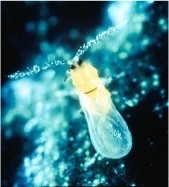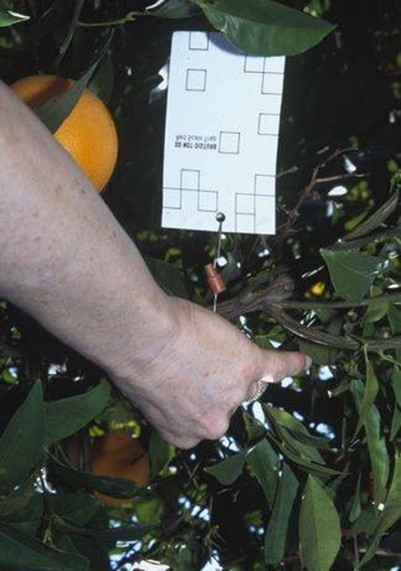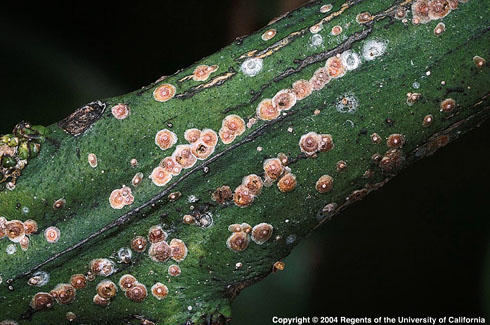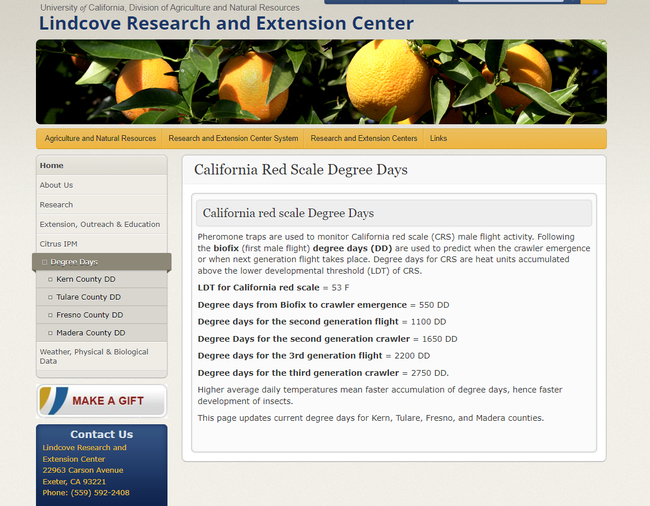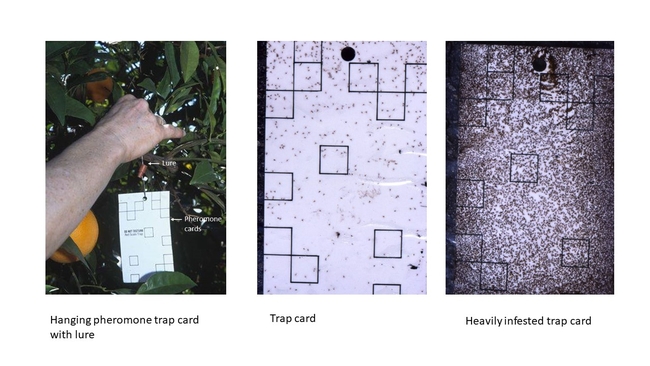
Posts Tagged: scale
Citricola Scale in the Big Valley
Sandipa Gautam, Area Citrus IPM Advisor serving Kern, Tulare, Fresno, and Madera counties has been maintaining a web page on the Lindcove Website Citrus IPM - Lindcove Research and Extension Center (ucanr.edu). Within this page, she writes a blog on pest issues that are problem for growers in the SJV region. For subscribing, click https://ucanr.edu/blogs/IPMBlog/ and enter your email address. You will receive an email to confirm subscription, follow the instructions to complete subscription. Every time a post is made you will receive and email notification. This page also hosts pest memos of this season and archives from the previous season along with links to Citrus related extension posts, newsletters.
Within the Citrus IPM tab, you will also find Degree Days, which is regularly updated for California red scale for four counties in the SJV. If you are in Ventura county or other citrus growing counties (not in the valley) and California red scale is a pest you manage and are interested in Degree Day calculation and predictions, please contact sangautam@Ucanr.edu .
If you would like to receive emails on pest memos/other events, please send an email to sangautam@ucanr.edu to be added to her email list.

citricola scale blog
Californina Red Scale News
Read all about Sandipa Gautam's Central Valley research and what chemicals are working. There was trouble loading the file,but you go to the bottom and click on "Attached File" You'll the wonderful work she is doing.
LinkstoPesticidetrialsonCRS
- CRStrial 2015
- CRStrial 2016
- CRStrial 2017
- CRStrial 2018
- CRStrial 2019
- CRSTrial2022
- CRSTrial2023Trial-1
- CRSTrial2023Trial-2

red scale feeding on grapefruit

CRS July Memo Page 1

CRS July Memo Page 2

CRS July Memo Page 3
CA Red Scale
From
Sandipa Gautam in the Central Valley
Hello everyone,
Please find first California red scale memo for 2024 season. CRS degree days for four counties, Kern, Tulare, Fresno, and Madera are updated on the LREC website. Please visit link for biweekly DD updates using the CIMIS station data https://lrec.ucanr.edu/Citrus_IPM/Degree_Days/.
Management choices for CRS – Mating disruption (CheckMate CRS), Biological control Aphytis melinus release; insecticides (Check UCIPM guidelines)
How can we better manage CRS – three key points to remember
- Spray applications are most effective when populations consist of immatures and are synchronized. Spray as crawlers of the first or second generation are emerging. Expect first generation crawlers in 1-3 weeks depending on your location.
- Monitor for CRS
- Pheromone cards for monitoring males, weekly or per flight.
- Leaf/twig sampling – sample the edge, interior or top of the tree. Determine if the scale is live or dead by rubbing your thumb.
- Use high gpa (750-1000) and drive <1.5 mph for a thorough coverage, except for Movento – apply at 250 GPA.
Attached is the first CRS memo of 2024 season with links to field trials conducted on CRS in the last decade.
Have a great season!

sandipa California Red Scale May 2024 Page 1

sandipa California Red Scale May 2024 Page 2

sandipa California Red Scale May 2024 Page 3
Red Scale Alert
California red scale season has started in the SJV
Sandipa Gautam - Citrus IPM Advisor
Based on traps placed at LREC citrus blocks, California red scale season began with Biofix on March 10. Pest Control Advisors in Kern, Tulare, and Fresno County reported that they have seen activity in the week of March 10.
Figure 1. California red scale male. Note: feathery antennae and brown band through the waist.
What is CRS Biofix?
CRS Biofix is the start of California red scale activity for this season. As weather warms up and heat units are accumulated above the lower developmental threshold of this insects, overwintering females start producing crawlers which develop. Males' complete development and fly to find third instar females to mate. Mated females then produce crawlers which is the First Generation of Crawlers, observed 550-degree days after the biofix.
What do males on the trap cards mean for management?
Pest control advisors have long used pheromone cards to monitor males and degree days to predict successive life event (crawler emergence) for timely management of CRS. Trap numbers may be different depending on the management choice.
Figure 2. Trap with pheromone placed within an arm's length inside the tree canopy. For assessment, count number of males within square box and multiply by 5.
- IGRs and Mating Disruption – few male scales may be on the cards as these two options affect males more than it does females. You may have lower males on card but have high CRS populations.
- Aphytis and Movento – Aphytis targets third instar females, thus affecting females more than it does males. Also, Movento controls CRS on twigs but not on wood. If Aphytis or Movento or both are used, you may see higher male numbers. If Movento was used, check the inner canopy branches, top of the tree for CRS patches.
Citrus entomology group will monitor degree days for four counties and update it biweekly on ucanr website https://lrec.ucanr.edu/Citrus_IPM/Degree_Days/.
Management is targeted at 1st and 2nd generations as the crawlers are emerging. Based on previous years, first generation crawler emergence occurs around 2nd/3rd week of May. As the degree day accumulation is temperature dependent, monitoring is critical to predict accurately.
Stay tuned for updates.
Monitoring for Citrus Red Scale
Monitoring California red scale populations by using pheromone traps and degree days
California red scale is an armored scale that attacks all citrus varieties. It attacks all aerial parts of the tree including leaves, fruits, twigs, and branches by sucking on plant tissue with its long filamentous stylet. Heavy infestations cause leaf yellowing and drop, dieback of twigs, and occasional death of the infested tree. Heavily infested fruits with patches of California red scale may be downgraded in the packinghouse. Growers use monitoring methods, i.e., pheromone trapping, examining fruit, and bin counts (at harvest) for making treatment decisions.
In the San Joaquin Valley, many citrus growers rely on the use of pheromone traps to monitor male-scale flights. Following the biofix (first male flight) degree day units (DD) are used to predict when the next crawler emergence or next-generation flights is occurring. Degree days are heat units accumulated above the lower developmental threshold of an insect and have been long used to monitor the seasonal activity of California red scale populations. Knowing when the most vulnerable life stage of the insect is present helps growers make timed insecticide applications.
Citrus IPM research group led by Dr. Sandipa Gautam at Lindcove Research and Extension Center updates degree day accumulation in the San Joaquin Valley counties. Information for different counties can be found here.
Pheromone traps are used to monitor either weekly changes in male flights or to track densities during flights, especially the fourth flight.
The squares represent 20% of the card – you count what is inside the squares on both sides and multiply by 5 to estimate the total number.
How to use pheromone traps for weekly monitoring male flights?
- Monitor 5 to 6 orchards that have a known population of California red scales every week,so thatyou can determine when flights are occurring and time sprays.
- Change the sticky cards weekly and the pheromone lure caps monthly through October.
- Use two to four pheromone traps per10-acre block;add two traps for each additional10 acres.
How to use trap card information to make management decisions?
- Hang pheromone traps with a fresh lure in early March to detect the biofix (first male flight). Historically, biofix for Kern County occurs around the 1st of March, and biofix for Tulare, Fresno, and Madera Counties occurs around March 15.
- Use the biofix and degree-days to predict when crawler emergence or next flight is occurring. Degree days are accumulated heat units over the lower developmental threshold of California red scale.
- Crawler emergence for first-generation will occur 550 degrees days after biofix.
- Subsequent flights will occur at intervals of 1,100-degree days after the biofix of the first male flight (1,100 DD for 2nd flight; 2,200 DD for 3rd flight; 3,300 DD for 4th flight and 4,400 DD for 5th flight). Subsequent crawler emergence for the 1st, 2nd, and 3rd generation occurs at 550 DD, 1650 DD, and 2750 DD after the biofix.
- Check the Lindcove Research and Extension Center Website for updated information on accumulated degree day
How to use pheromone traps to determine areas of heavy infestation?
- Use 2 to 4 pheromone traps per10-acre block;add 2 traps for each additional10 acres.
- Time placement of traps at the beginning of the biofix for the flight and remove them at the end of each flight and count scales and record the numbers.
In the past, when an average of more than 1,000 scales are trapped during the 4th flight and fruit is infested with scale at harvest, a pesticide application is planned for the next season. However, this threshold of 1,000 scales per flight developed in the 1980s is no longer a stand-alone tool for determining when treatments are necessary. It is critical to use other tactics, such as fruit and twig examination.
Note that pheromone cards are not reliable predictors of scale populations on their own. In all orchards in all growing regions,whether Aphytis wasps are released or not, conduct visual inspections of citrus fruit once a month during August, September, and October to confirm that fruit is free of scale.
Situation 1: Scale densities on traps may be high, but the fruit is free of scale:
- When Movento or Admire (and generics) are used because they remove scale from leaves and fruit but not the wood of the tree.
- Aphytis prefer to attack virgin female scales and the males may escape parasitization, resulting in a high number of male scales on traps.
Situation 2: Very few male scales on traps, but the scale is found on fruit
- When insect growth regulators (buprofezin and pyriproxyfen) are used, the frequently molting male scales are more affected than female scales.
- When mating disruption is used, males cannot find the trap cards so their densities on traps can be very low. A threshold of 50 scales per flight is helpful in determining if mating disruption is effective.
Consult UCIPM guidelines for management options.
And Read more from Citrus IPM News: https://ucanr.edu/blogs/blogcore/postdetail.cfm?postnum=52294

